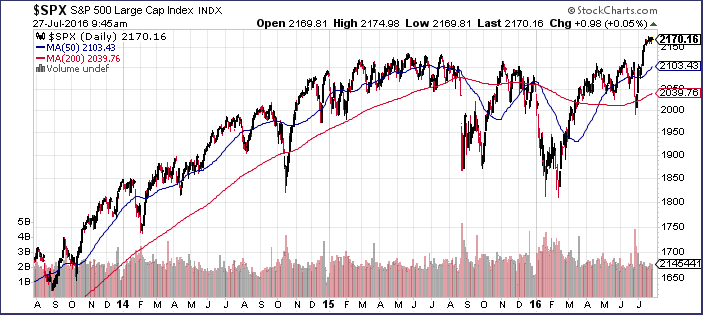One of the most common technical analysis tools that traders use is the simple moving average (SMA). In fact, when you create a stock’s bar chart, the 50-day SMA and the 200-day SMA, two of the most commonly-used SMAs, are often included by default.
As the name implies, a moving average line is simply a line that represents the mean average of a stock’s price over a set number of intervals. For example, the 50-day SMA on a daily chart will be a line that represents the average share price of the stock over the past 50 days. There is nothing inherently special about 50 and 200 days, but traders typically prefer to compare a shorter-term line with a longer-term one.
In the chart below of the S&P 500, the 50-day SMA is the blue line and the 200-day SMA is the red line.

Technical traders tend to use a stock’s current share price in coordination with its 50-day SMA and its 200-day SMA to determine a stock’s trend. Because the SMA’s are averages over an extended period of time, they represent smoothed trend lines that can eliminate much of the noise of daily trading.
If a stock is trading above its 50-day SMA, it is typically in a short-term uptrend. If the 50-day SMA is higher than the 200-day SMA, it is typically a sign of a longer-term uptrend.
As you can see, during the extended S&P 500 uptrend from 2013 through the middle of 2015, the S&P 500 spent a large amount of time above its 50-day SMA, but the 50-day SMA stayed above the 200-day SMA the entire time.
When the 50-day SMA crosses above the 200-day SMA, the lines form what’s known as a “golden cross.” Some traders use this event as a buy signal and an indication of the beginning of a long-term uptrend. When the 50-day SMA crosses below the 200-day SMA, it forms a “death cross.” As the name implies, technical analysts see this formation as a bearish sign and a sell signal.
In addition, the SMAs themselves often serve as resistance and support lines for a stock's share price.
As with any other technical trading tool, SMAs should be used in coordination with other technical indicators, market fundamentals and news. However, when understood and used properly, SMAs can provide some excellent longer-term perspective on volatile stocks and markets.
Do you have ideas for articles/interviews you'd like to see more of on Benzinga? Please email feedback@benzinga.com with your best article ideas. One person will be randomly selected to win a $20 Amazon gift card!© 2024 Benzinga.com. Benzinga does not provide investment advice. All rights reserved.
Trade confidently with insights and alerts from analyst ratings, free reports and breaking news that affects the stocks you care about.